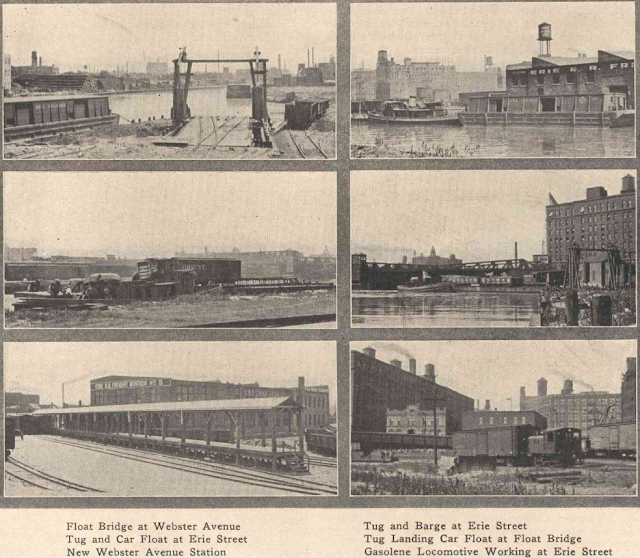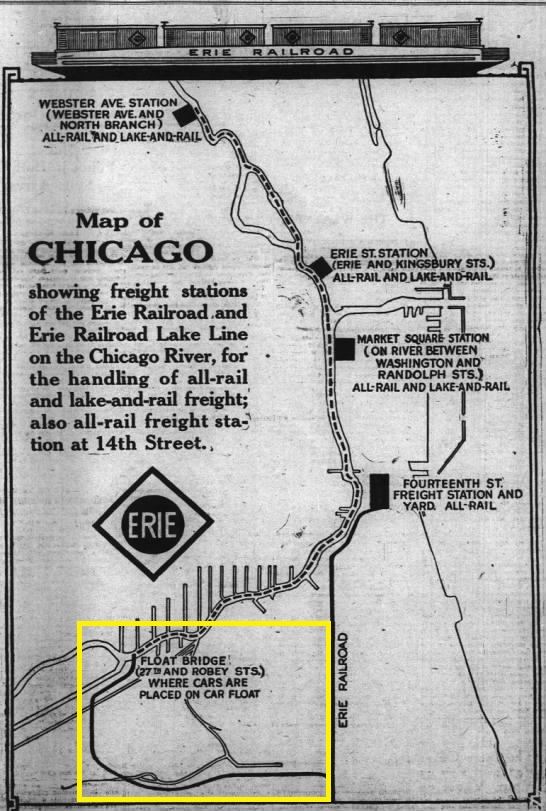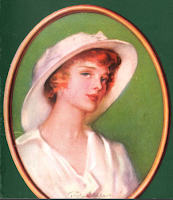A "signature image" for the post:
Before discussing the Erie ferry service, I need to describe the Chicago River & Indiana ferry service. I learned of the existence of the CR&I service from this map of the Erie service. I recognized the track in the yellow rectangle that I added as being owned by Chicago Junction/CR&I. The 14th Street Freight House would have served their ferries at the 18th Street Float Bridge.
The C&RI service was started during the 1911-12 Winter, and I think we can still see the slip that had the apron, or float bridge, for the car floats. The track layout back then was completely different. The map reminds me that both the West and East Arms of the South Fork of the South Branch of the Chicago River still existed. And the South Branch had not yet been filled in west of where the Sanitary and Ship Canal began. The map also shows the origins of the I&M Canal.
It is worth remembering that, because of the I&M Canal, Chicago started as a water transport economy, not a railroad economy. Industry grew along the river because the river was the main artery of commerce. The river used to be crowded with schooners, and then steamers, providing lake transportation. Even though Chicago by the 1910s was trying to move river commerce from the Chicago river to the Calumet River, industry was still built to use the river for transport. For example, Wacker Drive was not built until the 1920s.
So I think the C&RI took advantage of the river transport infrastructure that was already in place.
"The car floats were unloaded by laying down a gangplank to the car doors and the carrier's longshoremen or station crews would carry the cargo from the boxcar. When the close boxcars were empty, the cars on the far track were emptied by carrying the cargo through the cars on the near track. CR&I offered this service as a terminal switching service and Erie, NKP and Wabash used it." I wonder if those railroads being three of the five owners of the C&WI played a part in this usage. In 1913, the CR&I raised its ferry rates from "1 cent per 100 pounds, minimum 60,000 pounds per car" to "3 cents per 100 pounds or 5 cents per 100 pounds for less than carload freight." [Freight, Volume 14 and ICC Reports] We have to remember that a penny was worth enough back then that it could buy things. (I've heard of "penny candy?" And this was long before that.) I assume it was because of this rate increase that Erie bought its own two tugboats and car floats to start its own ferry business.
The Frederick V. Robbins burned anthracite so it was smokeless. The Erie's traffic manager hoped that others would notice the clean burning tug and the public would demand that others marine operators switch to anthracite. [Commerce, Volume 9, p23] I wonder if the Erie passenger trains burned anthracite coal. I know the Lackawanna did because their advertising featured Phoebe Snow. She was a fictional character dressed in white, including white gloves, to emphasize the cleanliness of the trains pulled by anthracite burning locomotives.
The ferry service started with the Erie Street Station. The service was popular enough that they soon added the Webster Avenue Station. A slip and apron, team and house tracks, a overhead crane and a Baldwin gasoline switcher were added to both stations in 1916. The map at the bottom of this page shows that they built their own slip and apron by their main freight house by 1917 so that they were independent of CR&I's tracks as well as the ferry service.
(new window) A silent film. The towboat at 2:37 and then at 2:48 shows why "clean burning" was a significant issue. At 2:59 we see the center platform that allows cargo for the boxcars on the outside track to be easily carried through empty boxcars on the inside track and then across gangplanks put in the doors of the boxcars on the inside track.
Erie Street Station slip:
Before, and during, these car float services, there were companies offering a lighter service. "For the lighter service a self propelled covered steam lighter is employed. Both carload and less than carload freight is unloaded from cars or docks and loaded on the lighter...Lightered freight is unloaded and also placed for consignees....Lighterage by car float can not be performed on the Chicago River any cheaper than by steam lighter, the gain by elimination of one handling being offset by the compulsory use of a small float holding eight cars, and the consequent spreading of the cost over less revenue tonnage." [Freight, Volume 14]
This 1917 map shows they built their own slip and apron by their 14th Street team tracks.
 |
| jon-n-bevliles |
Before discussing the Erie ferry service, I need to describe the Chicago River & Indiana ferry service. I learned of the existence of the CR&I service from this map of the Erie service. I recognized the track in the yellow rectangle that I added as being owned by Chicago Junction/CR&I. The 14th Street Freight House would have served their ferries at the 18th Street Float Bridge.
 |
| David Daruszka commented on a post |
 |
| Satellite |
 |
| David Daruszka posted |
 |
| Kevin Pahl posted |
 |
| By Carbutt, John, 1832-1905 -- Photographer [Public domain] via architecture.org [We are looking East towards the lake so the grain elevator on the right would be on Illinois Central's freight yard.] |
"The car floats were unloaded by laying down a gangplank to the car doors and the carrier's longshoremen or station crews would carry the cargo from the boxcar. When the close boxcars were empty, the cars on the far track were emptied by carrying the cargo through the cars on the near track. CR&I offered this service as a terminal switching service and Erie, NKP and Wabash used it." I wonder if those railroads being three of the five owners of the C&WI played a part in this usage. In 1913, the CR&I raised its ferry rates from "1 cent per 100 pounds, minimum 60,000 pounds per car" to "3 cents per 100 pounds or 5 cents per 100 pounds for less than carload freight." [Freight, Volume 14 and ICC Reports] We have to remember that a penny was worth enough back then that it could buy things. (I've heard of "penny candy?" And this was long before that.) I assume it was because of this rate increase that Erie bought its own two tugboats and car floats to start its own ferry business.
 |
| StreamLinerMemories |
The ferry service started with the Erie Street Station. The service was popular enough that they soon added the Webster Avenue Station. A slip and apron, team and house tracks, a overhead crane and a Baldwin gasoline switcher were added to both stations in 1916. The map at the bottom of this page shows that they built their own slip and apron by their main freight house by 1917 so that they were independent of CR&I's tracks as well as the ferry service.
(new window) A silent film. The towboat at 2:37 and then at 2:48 shows why "clean burning" was a significant issue. At 2:59 we see the center platform that allows cargo for the boxcars on the outside track to be easily carried through empty boxcars on the inside track and then across gangplanks put in the doors of the boxcars on the inside track.
Erie Street Station slip:
 |
| Dennis DeBruler commented on a post Within two years after they quit, they had removed the tracks and the float apron, but the slip had not been filled in. https://clearinghouse.isgs.illinois.edu/.../0bwq08007.jpg |
 |
| Dennis DeBruler commented on a post Remnants of the Erie Street Bridge abutments still exist. https://www.google.com/.../@41.8937266,-87.../data=!3m1!1e3 |
Webster Avenue Station slip:
 |
| Dennis DeBruler commented on a post I presume the slip was the north "bump" and that there was noticeable erosion in just two years. https://clearinghouse.isgs.illinois.edu/.../0bwq07092.jpg The shoreline is now occupied by a MWRD aeration facility and a wildlife site. https://www.google.com/.../data=!3m1!1e3!4m13!1m7!3m6... |
 |
| Dennis DeBruler commented on a post Plan 3 was the Deep Tunnel System. I'm still trying to figure out what Lake-and-Rail was. The "map opposite" is the one already posted by David Daruszka's comment. https://books.google.com/books?id=i-UNAQAAMAAJ... |
Before, and during, these car float services, there were companies offering a lighter service. "For the lighter service a self propelled covered steam lighter is employed. Both carload and less than carload freight is unloaded from cars or docks and loaded on the lighter...Lightered freight is unloaded and also placed for consignees....Lighterage by car float can not be performed on the Chicago River any cheaper than by steam lighter, the gain by elimination of one handling being offset by the compulsory use of a small float holding eight cars, and the consequent spreading of the cost over less revenue tonnage." [Freight, Volume 14]
This 1917 map shows they built their own slip and apron by their 14th Street team tracks.
 |
| Thomas Manz commented on a post |
<update>
The straightening of the river erased any evidence of the 18th Street slip and their 14th Street Freight House.
 |
| MWRD posted A view to the northeast showing the South Branch of the Chicago River in an area north of 18th Street on July 11, 1900. Dennis DeBruler shared Click the photo to see my comment on the MWRD post. |
 |
| Dennis DeBruler commented on the MWRD post The long building has the classic architecture of a railroad freight house. According to the bend in the river in the photo and this map, it was a little west of Clark Street and a little south of 14th Street, https://maps.app.goo.gl/5pPAUv7VixUHT51s8. I suspect that the photo was taken from the previous St. Charles Air Line Bridge. The freight house probably belongs to an owner of the C&WI (C&EI, GTW, Wabash, Erie, and Monon), but I can not determine which one. 1929/29 Englewood Quad @ 24,000 Bob Lalich: Dennis DeBruler - that is the Erie freight house before it was expanded. Note that the boat on the left is Erie as well. Erie ran a car float service on the Chicago River at that time. Dennis DeBruler: Bob Lalich Thanks. I have moved this information from my C&WI overview to my Erie marine operation notes. |
</update>
No comments:
Post a Comment